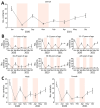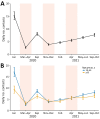Social Contact Patterns and Age Mixing before and during COVID-19 Pandemic, Greece, January 2020-October 2021
- PMID: 39714284
- PMCID: PMC11682816
- DOI: 10.3201/eid3101.240737
Social Contact Patterns and Age Mixing before and during COVID-19 Pandemic, Greece, January 2020-October 2021
Abstract
We collected social contact data in Greece to measure contact patterns before (January 2020) and during the COVID-19 pandemic (March 2020-October 2021) and assess the effects of social distancing over time. During lockdowns, mean daily contacts decreased to 2.8-5.9 (mean prepandemic 20.4). Persons >65 years of age retained the fewest contacts during the pandemic (2.1-4.1). Compared with the first lockdown (March-April 2020), the second lockdown (November-December 2020) and third lockdown (April 2021) showed higher numbers of contacts (incidence rate ratio 1.50 [95% CI 1.27-1.76] in second lockdown and 2.19 [95% CI 1.86-2.58] in third lockdown). In 2021, an increase in contacts was apparent, which persisted during the April 2021 lockdown among persons 18-64 years of age. Our study provides evidence of the waning observance of physical distancing. Effective risk communication alongside targeted social distancing could offer alternatives to repeated lockdowns.
Keywords: COVID-19; Greece; SARS-CoV-2; basic reproduction number; coronavirus disease; pandemic; prevention and control; respiratory infections; severe acute respiratory syndrome coronavirus 2; social distancing; surveys and questionnaires; transmission; viruses; zoonoses.
Figures







Similar articles
-
Effects of Social Distancing Measures during the First Epidemic Wave of Severe Acute Respiratory Syndrome Infection, Greece.Emerg Infect Dis. 2021 Feb;27(2):452-462. doi: 10.3201/eid2702.203412. Emerg Infect Dis. 2021. PMID: 33496221 Free PMC article.
-
Social contact patterns during the early COVID-19 pandemic in Norway: insights from a panel study, April to September 2020.BMC Public Health. 2024 May 29;24(1):1438. doi: 10.1186/s12889-024-18853-8. BMC Public Health. 2024. PMID: 38811933 Free PMC article.
-
Impact of physical distancing measures against COVID-19 on contacts and mixing patterns: repeated cross-sectional surveys, the Netherlands, 2016-17, April 2020 and June 2020.Euro Surveill. 2021 Feb;26(8):2000994. doi: 10.2807/1560-7917.ES.2021.26.8.2000994. Euro Surveill. 2021. PMID: 33632374 Free PMC article.
-
Quarantine alone or in combination with other public health measures to control COVID-19: a rapid review.Cochrane Database Syst Rev. 2020 Sep 15;9(9):CD013574. doi: 10.1002/14651858.CD013574.pub2. Cochrane Database Syst Rev. 2020. PMID: 33959956 Free PMC article.
-
Rapid Review of Social Contact Patterns During the COVID-19 Pandemic.Epidemiology. 2021 Nov 1;32(6):781-791. doi: 10.1097/EDE.0000000000001412. Epidemiology. 2021. PMID: 34392254 Free PMC article.
References
-
- European Centre for Disease Prevention and Control. Considerations relating to social distancing measures in response to COVID-19–second update. Stockholm: The Centre; 2020.
MeSH terms
LinkOut - more resources
Full Text Sources
Medical
Miscellaneous

